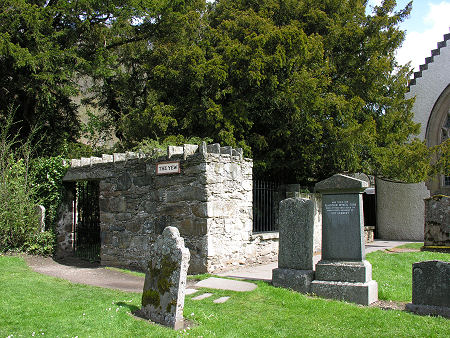| This Week’s Topic… | |

Best viewed in
|
The Fortingall Yew
In the churchyard of Fortingall Church near the east end of the attractive village of Fortingall is the Fortingall Yew, believed to be 5,000 years old and quite possibly the oldest living thing on earth. The footpath through the churchyard to the yew carries a series of inscriptions that help set 5,000 years in perspective: but the truth is that for mere humans it is a almost unimaginable length of time. The Fortingall Yew was a sapling when our Stone Age ancestors were building a burial cairn west of today's Fortingall, and was already 1000 years old when the very first Bronze Age settlers left their mark on the surrounding landscape. Carrying the story forward, the tree was already 3,000 years old when Christ was born and when, it is said, Pontius Pilate was born here in Fortingall. Yew trees were viewed as sacred by our pagan ancestors and by the early Christians, so it is perhaps not surprising that when a religious community was founded here in the 600s it should have been established close to what must already have been a huge tree. More recent history has been rather less kind to the Fortingall Yew. When the early traveler Thomas Pennant visited Fortingall in 1769 he reported that the trunk of the tree measured 56½ft (17.5m) in diameter, though he also reported that it had been damaged by bonfires lit to celebrate the festival of Beltane. In 1833 another visitor noted that large parts of the trunk had been cut away, much of it to make souvenir quaiches or celebration cups. What was left resembled a semicircular wall, though there was also new growth up to a height of 30ft. By 1854 it was reported that part of the trunk formed an arch through which funeral processions passed. The first effort to protect the tree was the building of a wall around in in 1785, though as already noted this seems to have done little to prevent further damage. The wall was rebuilt with gaps for viewing protected by railings in 1842, and this is the wall that still surrounds the tree today. A line of posts in the ground shows the circumference of the yew as it stood in 1769. What remains today bears little resemblance. While the tree miraculously continues to grow, what is left is more like a grove of small individual trees than the single mighty trunk that once stood here. But while the Fortingall Yew might only be a shadow of its former self, visiting it remains a deeply impressive experience. |
